Effect of Initial Predeformation on the Plastic Properties of Rolled Sheets of AISI 304L Austenitic Steel
Abstract
1. Introduction
2. Influence of The Direction of Initial Predeformation on the Plastic Anisotropy
AISI 304L Steel
3. Results
3.1. Pre-Deformation in the Rolling Direction
3.2. Pre-Deformation in the Transverse Direction
3.3. Pre-Deformed Sample at 45 Degrees to the Rolling Direction
4. Conclusions
- For the pre-deformation in the rolling direction:
- For the pre-deformation in the transverse direction:
- For the pre-deformed sample at 45 degrees to the rolling direction
Author Contributions
Funding
Institutional Review Board Statement
Informed Consent Statement
Data Availability Statement
Conflicts of Interest
Appendix A. Material and Methods
Appendix A.1. Experimental Investigation on the Influence of Initial Predeformation on the Strength Properties of AISI 304L Steel
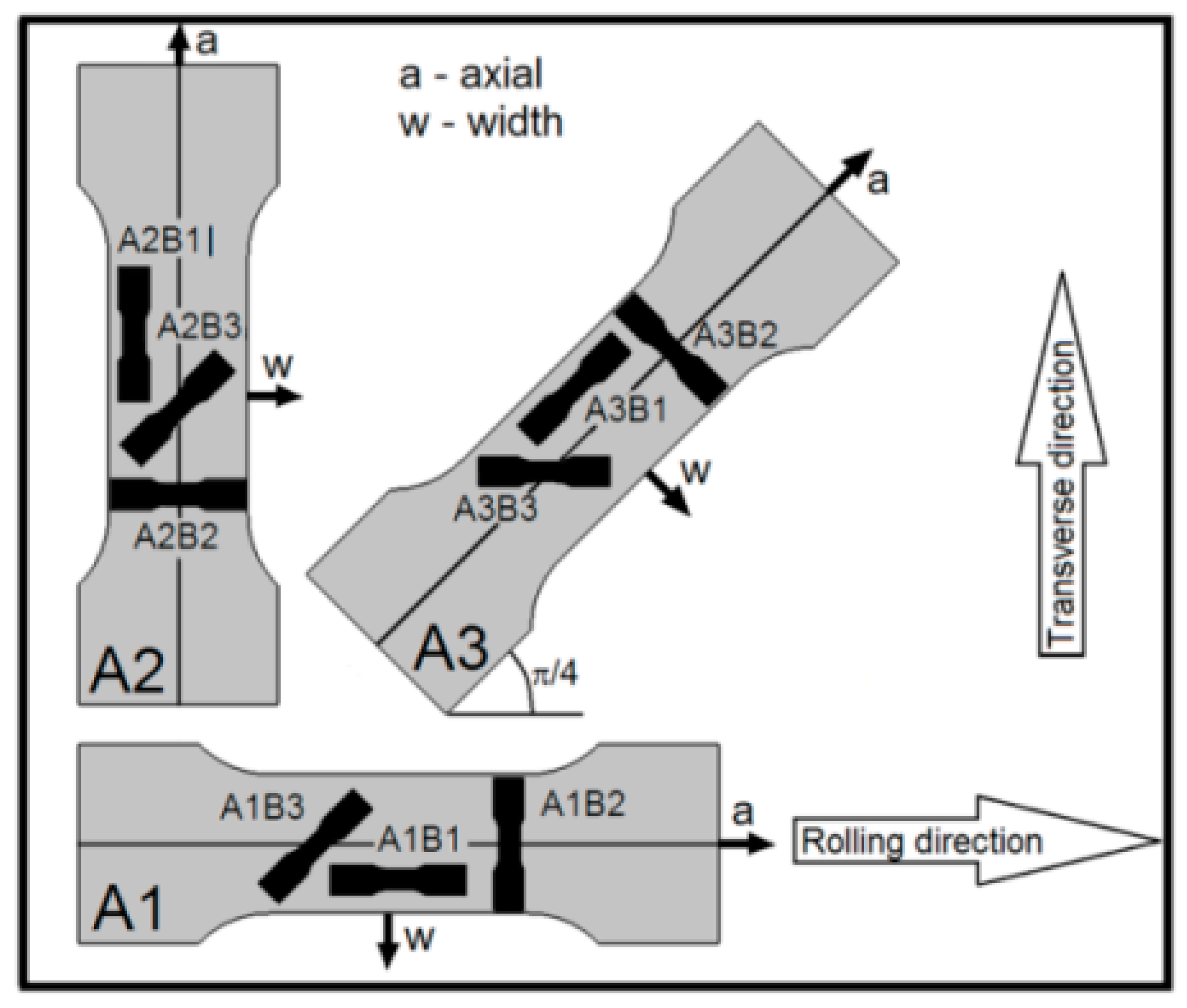
| C | Mn | Si | P | S | Cu | Cr | Ni | N | Other |
|---|---|---|---|---|---|---|---|---|---|
| 0.078 | 1.95 | 0.750 | 0.04 | 0.02 | - | 19 | 9.5 | 0.1 | - |
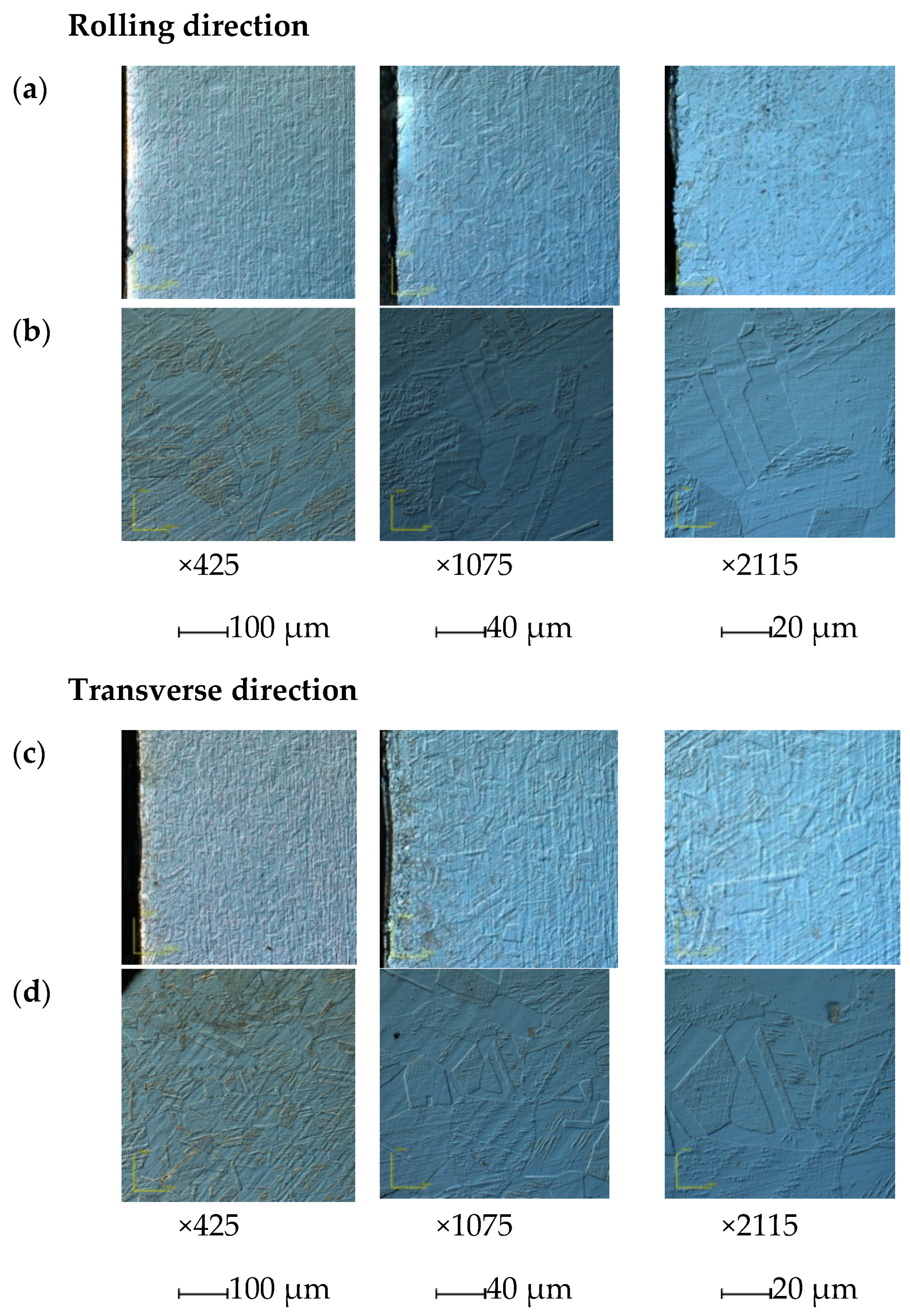

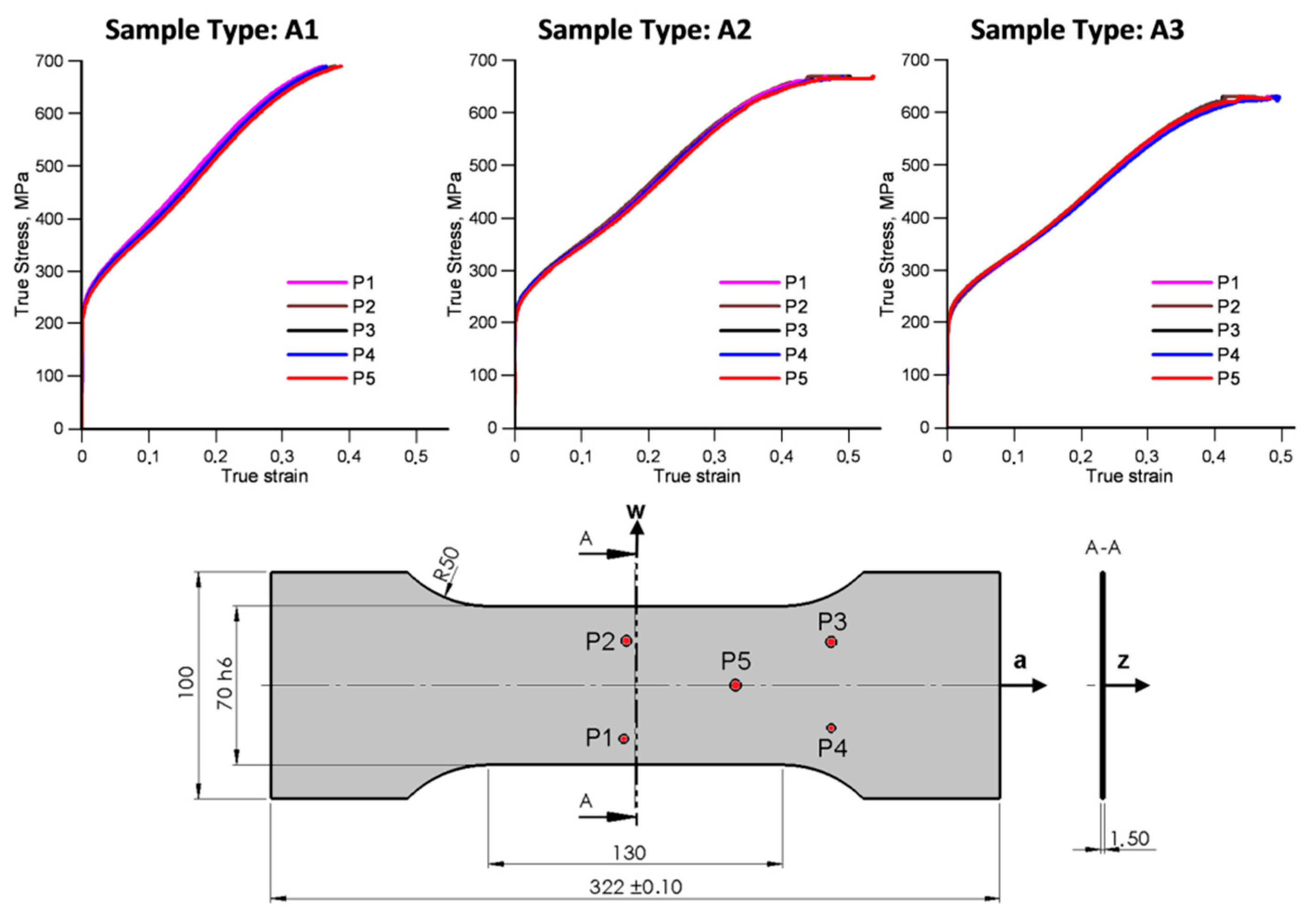


| Samples as Received (Black) | Pre-Deformation: 18% (Blue) | Pre-Deformation: 30% (Red) |
|---|---|---|
| A1B1_0 | A1B1_18 | A1B1_30 |
| A1B2_18 | A1B2_30 | |
| A1B3_18 | A1B3_30 | |
| A2B1_0 | A2B1_18 | A2B1_30 |
| A2B2_18 | A2B2_30 | |
| A2B3_18 | A2B3_30 | |
| A3B1_0 | A3B1_18 | A3B1_30 |
| A3B2_18 | A3B2_30 | |
| A3B3_18 | A3B3_30 |
Appendix A.2. Metallographic Examinations
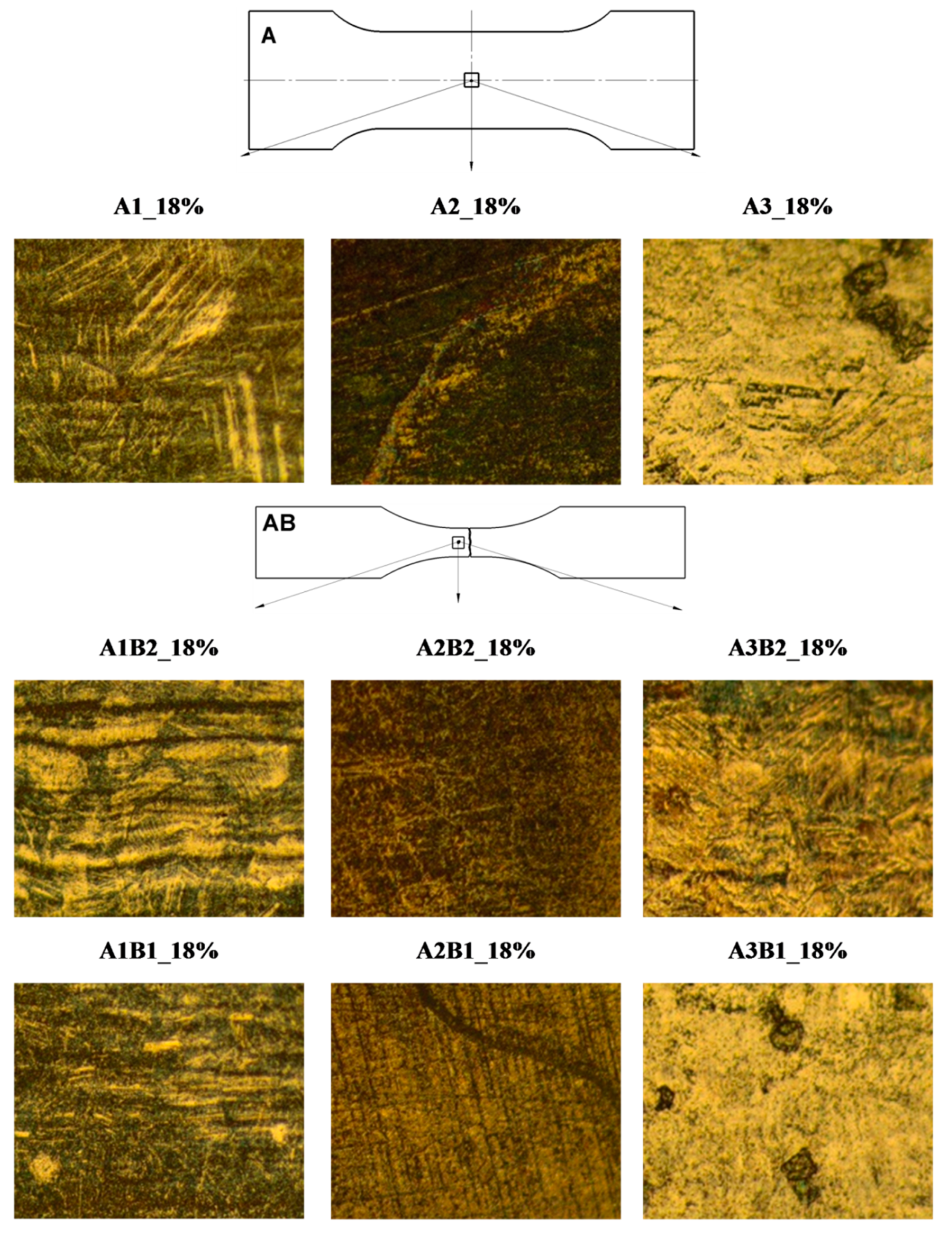
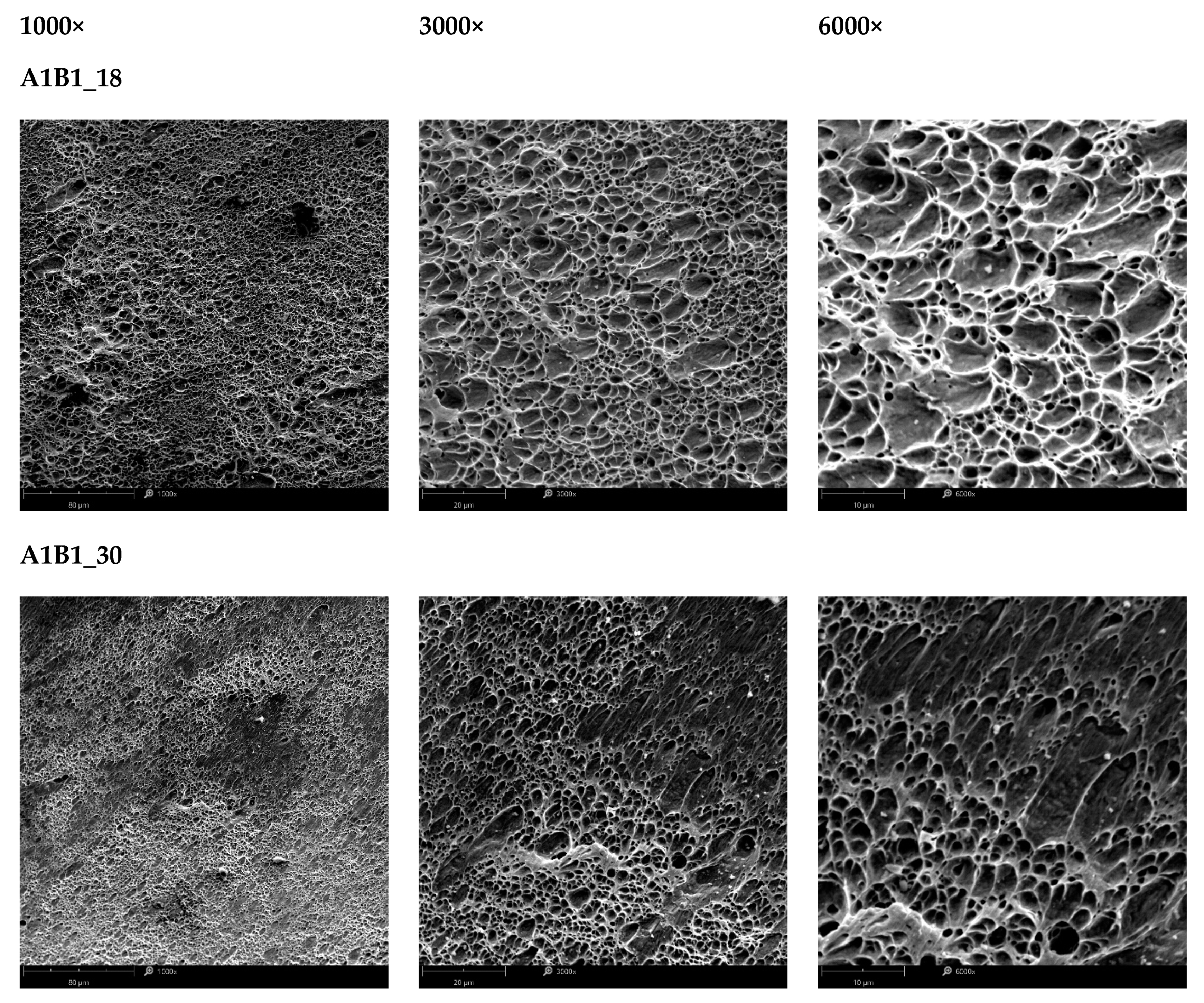
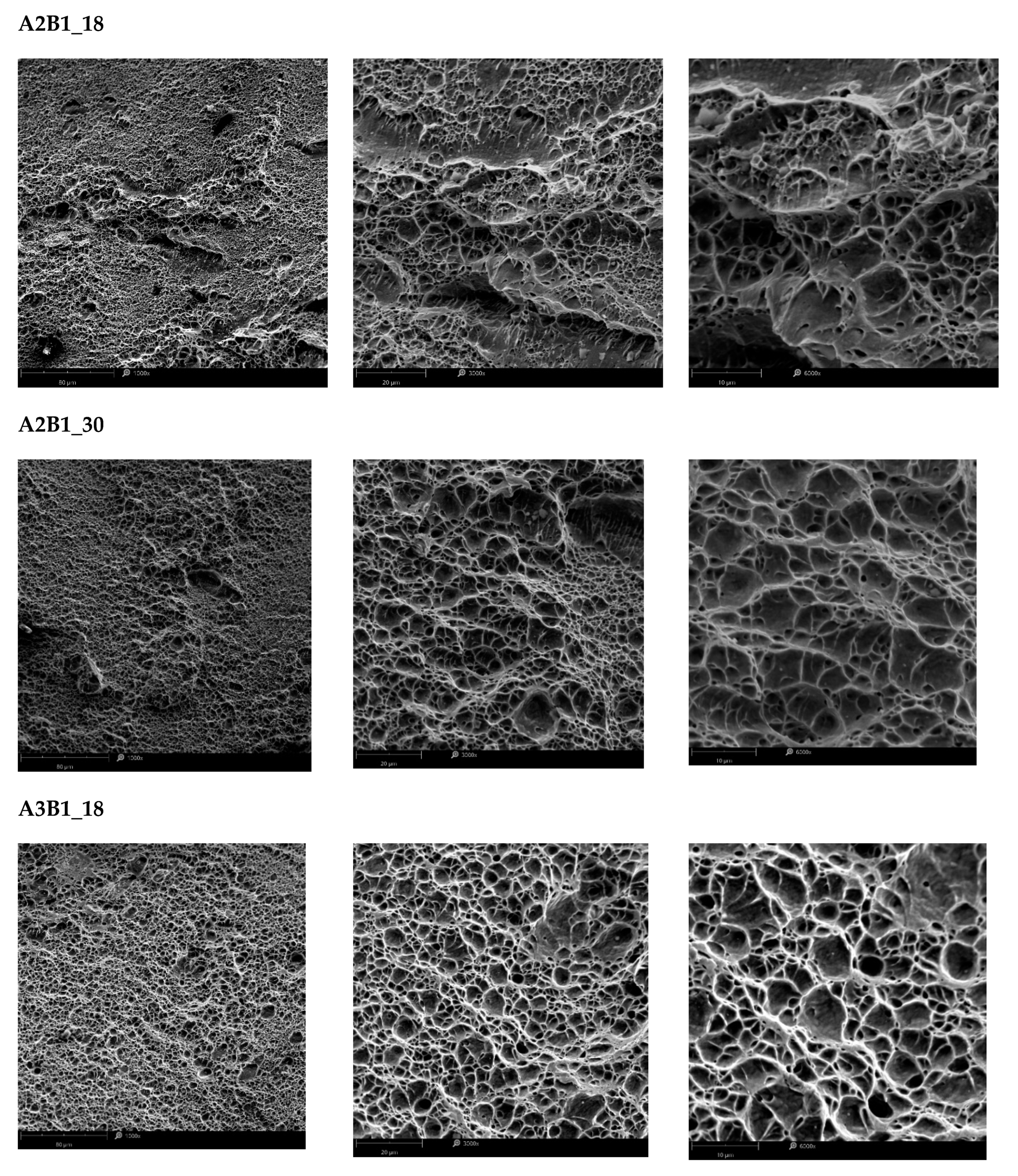
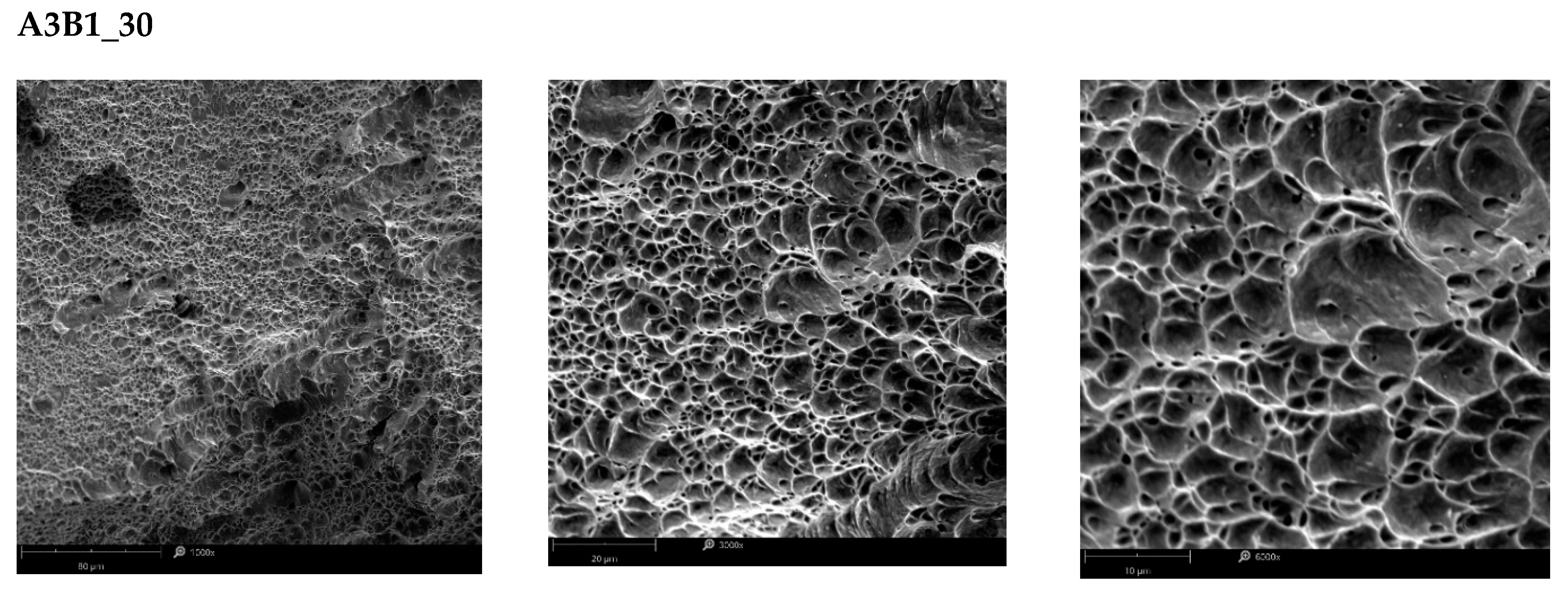
References
- Hu, J.; Du, L.-X.; Wang, J.-J.; Xie, H.; Gao, C.-R.; Misra, R. Structure–mechanical property relationship in low carbon microalloyed steel plate processed using controlled rolling and two-stage continuous cooling. Mater. Sci. Eng. A 2013, 585, 197–204. [Google Scholar] [CrossRef]
- Kocks, U.F.; Tomé, C.N.; Wenk, H.-R. Texture and Anisotropy: Preferred Orientations in Polycrystals and Their Effect on Materials Properties; Cambridge University Press: Cambridge, UK, 1998; p. 391. [Google Scholar]
- Humphreys, F.J.; Hartherly, M. Recrystallization and Related Annealing Phenomena, 2nd ed.; Elsevier Ltd.: Amsterdam, The Netherlands, 2004. [Google Scholar]
- Hosferd, W.F.; Caddell, R.M. Metal forming. In Mechanics and Metallurgy, 4th ed.; Cambridge University Press: Cambridge, UK, 2011. [Google Scholar]
- Aleksandrovic, S.; Stefanovic, M.; Adamovic, D.; Lazic, V. Variation of normal anisotropy ratio “r” during plastic forming. J. Mech. Eng. 2009, 55, 392–399. [Google Scholar]
- Naka, T.; Nakayama, Y.; Uemori, T.; Hino, R.; Yoshida, F. Effects of temperature on yield locus for 5083 aluminum alloy sheet. J. Mater. Processing Technol. 2003, 140, 493–499. [Google Scholar] [CrossRef]
- Plunkett, B.; Cazacu, O.; Barlat, F. Orthotropic yield criteria for description of the anisotropy in tension and compression of sheet metals. Int. J. Plast. 2008, 24, 847–866. [Google Scholar] [CrossRef]
- Lian, J.Y.; Shen, F.; Jia, X.; Ahn, D.-C.; Chae, D.-C.; Münstermann, S.; Bleck, W. An evolving non-associated Hill48 plasticity model accounting for anisotropic hardening and r-value evolution and its application to forming limit prediction. Int. J. Solids Struct. 2018, 151, 20–44. [Google Scholar] [CrossRef]
- Bandyopadhyay, K.; Basak, S.; Prasad, K.S.; Lee, M.-G.; Panda, S.K.; Lee, J. Improved formability prediction by modeling evolution of anisotropy of steel sheets. Int. J. Solids Struct. 2019, 156–157, 263–280. [Google Scholar] [CrossRef]
- Vegtera, H.; van den Boogaardb, A.H. A plane stress yield function for anisotropic sheet material by interpolation of biaxial stress states. Int. J. Plast. 2006, 22, 557–580. [Google Scholar] [CrossRef]
- Safaei, M.; De Waele, W. Evolution of anisotropy of sheet metals during plastic deformation. Int. J. Sustain. Constr. Design 2013, 4, 1–8. [Google Scholar] [CrossRef]
- Graf, A.F.; Hosford, W.F. Calculations of forming limit diagram for changing strain paths. Metall. Mater. Trans. A 1993, 24, 2497–2501. [Google Scholar] [CrossRef]
- Hill, R.; Hecker, S.S.; Stout, M.G. An investigation of plastic flow and differential work hardening in orthotropic brass tubes under fluid pressure and axial load. Int. J. Solids Struct. 1994, 31, 2999–3021. [Google Scholar] [CrossRef]
- Cvitanic, V.; Kovacic, M. Algorithmic formulations of evolutionary anisotropic plasticity models based on non-associated flow rule. Lat. Am. J. Solids Struct. 2017, 14, 1853–1871. [Google Scholar] [CrossRef][Green Version]
- Hosford, W.F. A generalized isotropic yield criterion. J. Appl. Mech. 1972, 39, 607–609. [Google Scholar] [CrossRef]
- Kuroda, M.; Tvergaard, V. A phenomenological plasticity model with non-normality effects representing observations in crystal plasticity. J. Mech. Phys. Solids 2001, 49, 1239–1263. [Google Scholar] [CrossRef]
- Sener, B.; Esener EFirat, M. Modeling plastic anisotropy evolution of AISI 304 steel sheets by a polynomial yield function. SN Appl. Sci. 2021, 3, 181. [Google Scholar] [CrossRef]
- Peeters, B.; Seefeldt, M.; Teodosiu, C.; Kalidindi, S.R.; Van Houtte, P.; Aernoudt, E. Work-hardening/softening behavior of B.C.C. polycrystals during changing strain path: I. An integrated model based on substructure and texture evolution, and its prediction of the stress-strain behaviors of an IF steel during two-stage strain path. Acta Mater. 2001, 49, 1607–1619. [Google Scholar] [CrossRef]
- Nesterova, E.V.; Bacroix, B.; Teodosiu, C. Microstructure and texture evolution under strain-path changes in low-carbon interstitial-free steel. Metall. Mater. Trans. A 2001, 32, 2527–2538. [Google Scholar] [CrossRef]
- Remy, L. The interaction between slip and twinning systems and the influence of twinning on the mechanical-behavior of fcc metals and alloys. Metall. Trans. A 1981, 12, 387–408. [Google Scholar] [CrossRef]
- Karjalainen, L.P.; Taulavuori, T.; Sellman, M.; Kyröläinen, A. Some strengthening methods for austenitic stainless steels. Steel. Res. Int. 2008, 79, 404–412. [Google Scholar] [CrossRef]
- Gavriljuk, V.G.; Berns, H.; Escher, C.; Glavatskaya, N.I.; Sozinov, A.; Petrov, Y. Grain boundary strengthening in austenitic nitrogen steels. Mater. Sci. Eng. A 1999, 271, 14–21. [Google Scholar] [CrossRef]
- Sabooni, S.; Karimzadeh, F.; Enayati, M.H. Thermal stability study of ultrafine grained 304L stainless steel produced by martensitic process. J. Mater. Eng. Perform. 2014, 23, 1665–1672. [Google Scholar] [CrossRef]
- Gong, N.; Wu, H.-B.; Yu, Z.-C.; Niu, G.; Zhang, D. Studying mechanical properties and micro deformation of ultrafine-grained structures in austenitic stainless steel. Metals 2017, 7, 188. [Google Scholar] [CrossRef]
- Xu, D.M.; Li, G.Q.; Wan, X.L.; Xiong, R.L.; Xu, G.; Wu, K.M.; Somani, M.C.; Misra, R.D.K. Deformation behavior of high yield strength—High ductility ultrafine-grained 316LN austenitic stainless steel. Mater. Sci. Eng. A 2017, 688, 407–415. [Google Scholar] [CrossRef]
- Misra, R.D.K.; Zhang, Z.; Jia, Z.; Somani, M.C.; Karjalainen, L.P. Probing deformation processes in near-defect free volume in high strength—high ductility nanograined/ultrafine-grained (NG/UFG) metastable austenitic stainless steels. Scr. Mater. 2010, 63, 1057–1060. [Google Scholar] [CrossRef]
- Ravi Kumar, B.; Sharma, S. Recrystallization behavior of a heavily deformed austenitic stainless steel during iterative type annealing. Metall. Mater. Trans. A 2014, 45, 6027–6038. [Google Scholar] [CrossRef]
- Mallick, P.; Tewary, N.K.; Ghosh, S.K.; Chattopadhyay, P.P. Microstructure-tensile property correlation in 304 stainless steel after cold deformation and austenite reversion. Mater. Sci. Eng. A 2017, 707, 488–500. [Google Scholar] [CrossRef]
- Hedayati, A.A.; Najafizadeh, A.; Kermanpur, A.; Forouzan, F. The e ffect of cold rolling regime on microstructure and mechanical properties of AISI 304L stainless steel. Mater. Sci. Eng. A 2010, 210, 1017–1023. [Google Scholar]
- Komatsu, T.; Matsumura, T.; Torizuka, S. Effect of grain size in stainless steel on cutting performance in micro-scale cutting. Int. J. Autom. Technol. 2011, 5, 334–341. [Google Scholar] [CrossRef]
- Behjati, P.; Kermanpur, A.; Karjalainen, L.P.; Järvenpää, A.; Jaskari, M.; Samaei Baghbadorani, H.; Najafizadeh, A.; Hamada, A. Influence of prior cold rolling reduction on microstructure and mechanical properties of a reversion annealed high-Mn austenitic steel. Mater. Sci. Eng. A 2016, 650, 119–128. [Google Scholar] [CrossRef]
- Lo, K.H.; Shek, C.H.; Lai, J.K.L. Recent developments in stainless steels. Mater. Sci. Eng. R 2009, 65, 39–104. [Google Scholar] [CrossRef]
- Xu, D.M.; Wan, X.L.; Yu, J.X.; Xu, G.; Li, G.Q. Effect of grain refinement on strain hardening and fracture in austenitic stainless steel. Mater. Sci. Technol. 2018, 34, 1344–1352. [Google Scholar]
- Di Schino, A.; Salvatori, I.; Kenny, J.M. Effects of martensite formation and austenite reversion on grain refining of AISI 304 stainless steel. J. Mater. Sci. 2002, 37, 4561–4565. [Google Scholar] [CrossRef]
- Zubelewicz, A.; Oliferuk, W. Mechanisms-based viscoplasticity: Theoretical approach and experimental validation for steel 304L. Sci. Rep. 2016, 6, 23681. [Google Scholar] [CrossRef]
- Zubelewicz, A. Tensor representations in application to mechanisms-based constitutive modeling. Tech. Rep. ARA2 2015, 1–5. [Google Scholar] [CrossRef]
- Rauch, E.F.; Gracio, J.J.; Barlat, F.; Vincze, G. Modelling the plastic behavior of metals under complex loading conditions. Model. Simul. Mater. Sci. Eng. 2011, 19, 1–18. [Google Scholar] [CrossRef]
- Baghbadorani, H.S.; Kermanpur, A.; Najafizadeh, A.; Behjati, P.; Rezaee, A.; Moallemi, M. An investigation on microstructure and mechanical propertiesof a Nb-microalloyed nano/ultrafine grained 201 austenitic stainless steel. Mater. Sci. Eng. A 2015, 636, 593–599. [Google Scholar] [CrossRef]
- Ammarullah, M.I.; Afif IYMaula, M.I.; Winarni, T.I.; Tauviqirrahman, M.; Akbar, I.; Basri, H.; van der Heide, E.; Jamari, J. Tresca Stress Simulation of Metal-on-Metal Total Hip Arthroplasty during Normal Walking Activity. Materials 2021, 14, 7554. [Google Scholar] [CrossRef] [PubMed]
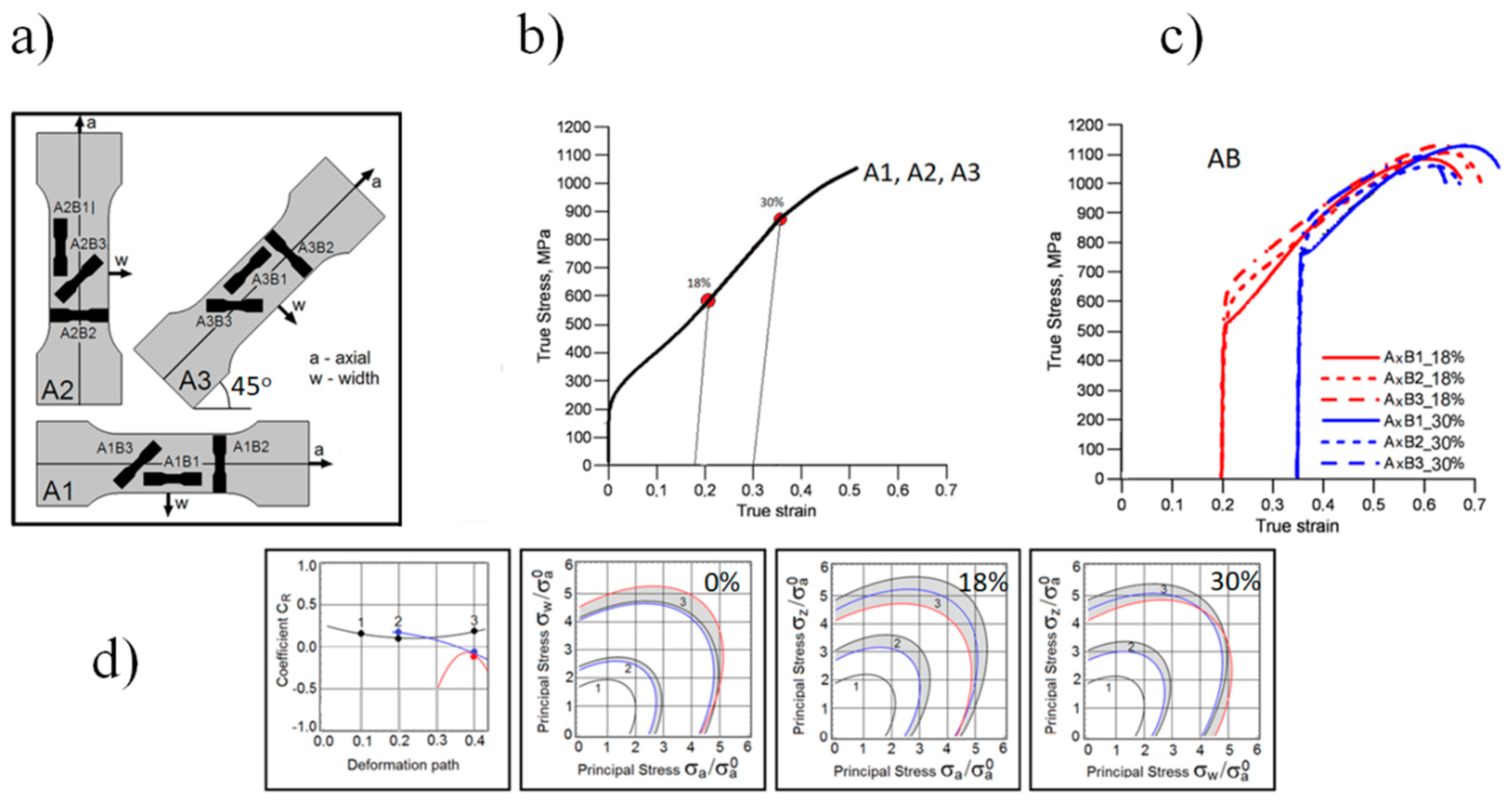

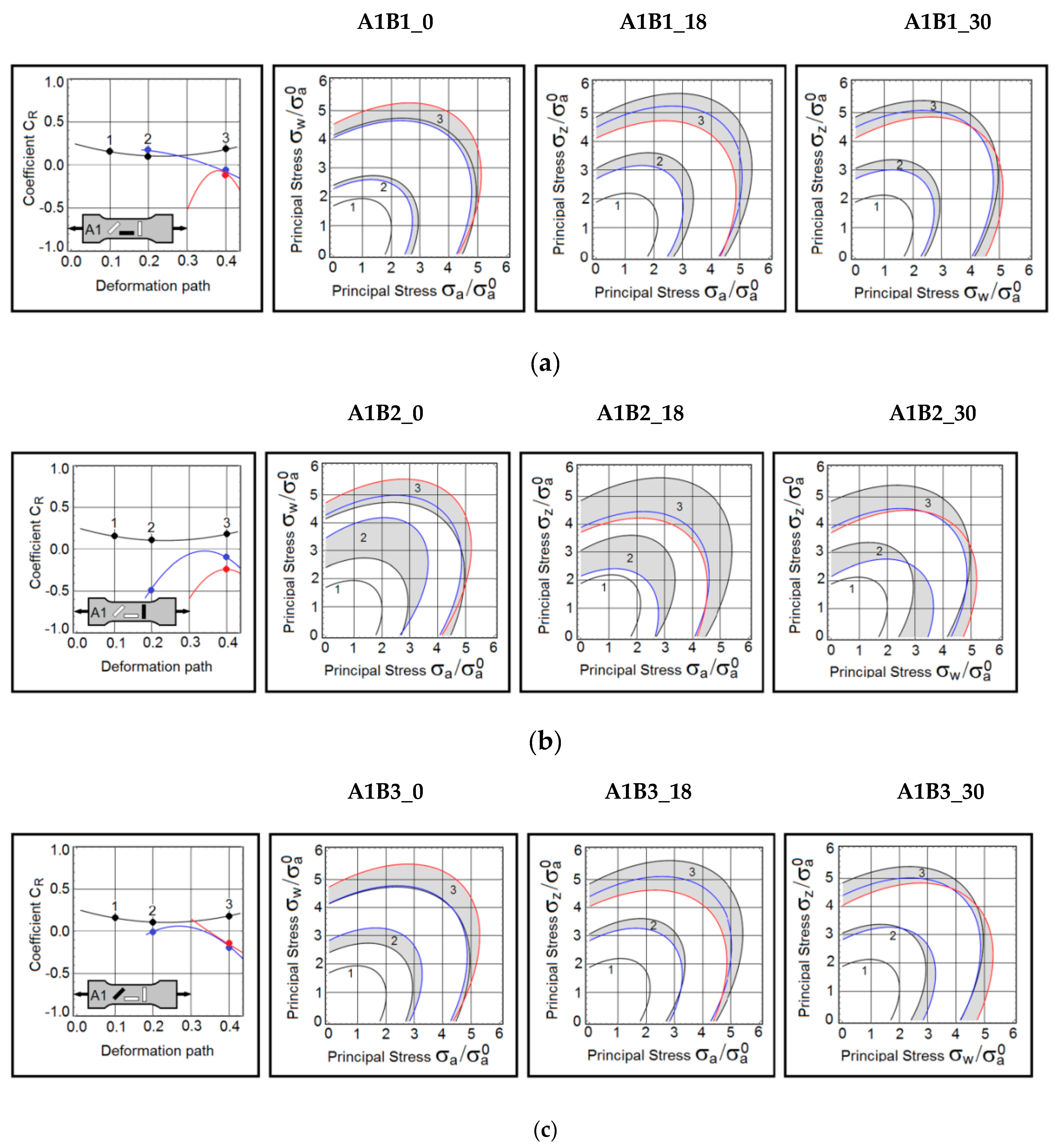
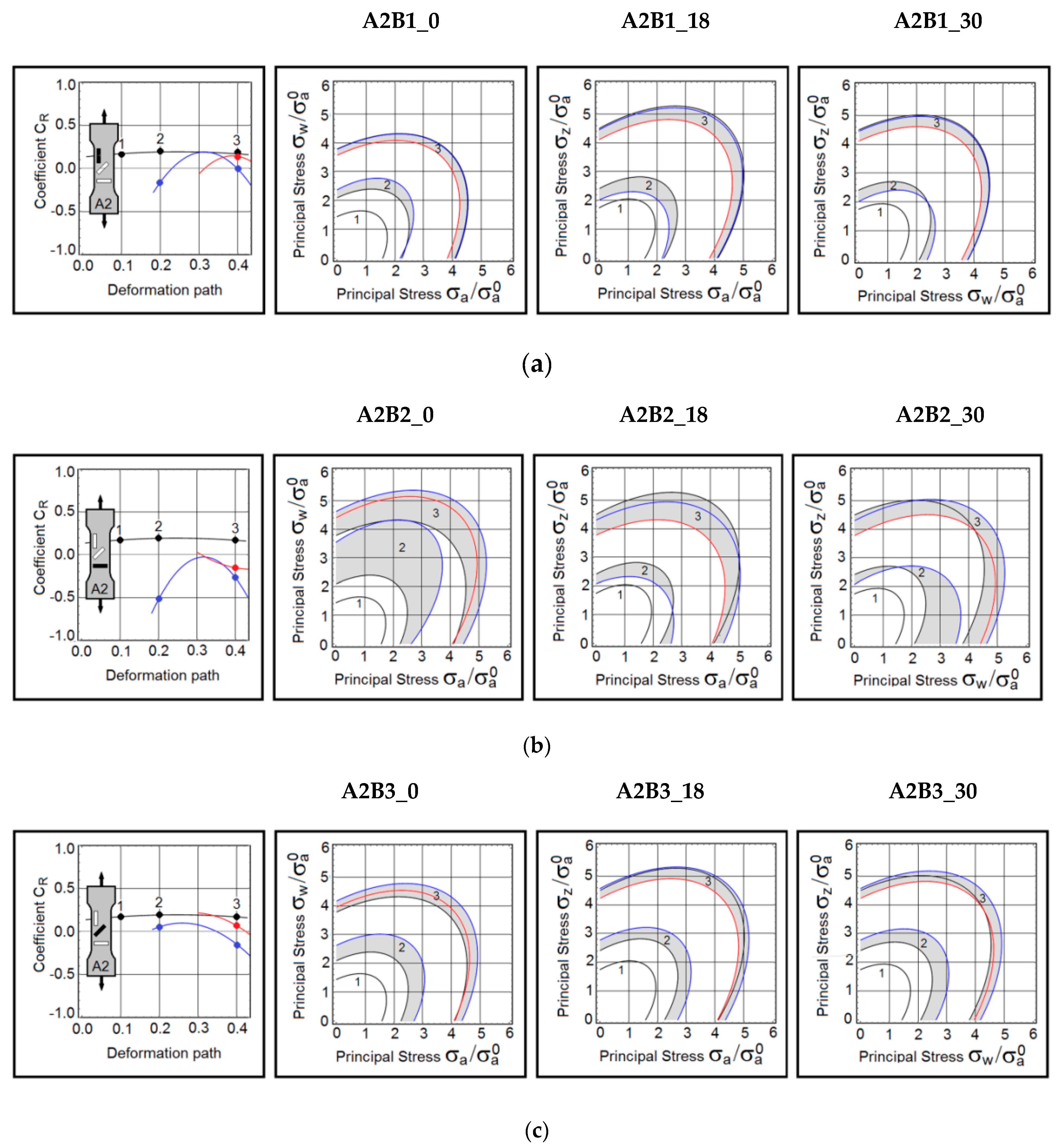
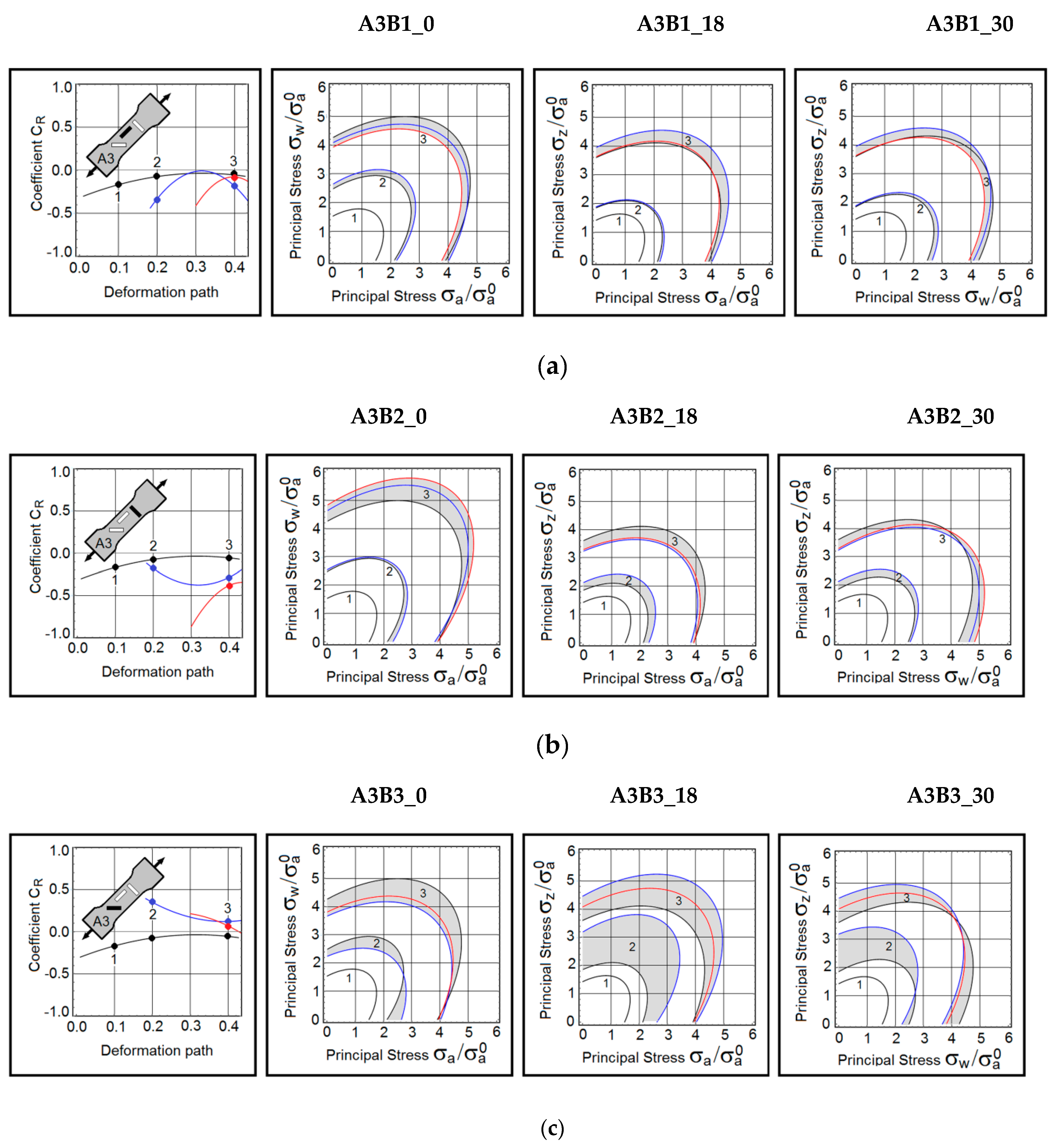
Publisher’s Note: MDPI stays neutral with regard to jurisdictional claims in published maps and institutional affiliations. |
© 2022 by the authors. Licensee MDPI, Basel, Switzerland. This article is an open access article distributed under the terms and conditions of the Creative Commons Attribution (CC BY) license (https://creativecommons.org/licenses/by/4.0/).
Share and Cite
Szusta, J.; Zubelewicz, A. Effect of Initial Predeformation on the Plastic Properties of Rolled Sheets of AISI 304L Austenitic Steel. Materials 2022, 15, 3575. https://doi.org/10.3390/ma15103575
Szusta J, Zubelewicz A. Effect of Initial Predeformation on the Plastic Properties of Rolled Sheets of AISI 304L Austenitic Steel. Materials. 2022; 15(10):3575. https://doi.org/10.3390/ma15103575
Chicago/Turabian StyleSzusta, Jaroslaw, and Aleksander Zubelewicz. 2022. "Effect of Initial Predeformation on the Plastic Properties of Rolled Sheets of AISI 304L Austenitic Steel" Materials 15, no. 10: 3575. https://doi.org/10.3390/ma15103575
APA StyleSzusta, J., & Zubelewicz, A. (2022). Effect of Initial Predeformation on the Plastic Properties of Rolled Sheets of AISI 304L Austenitic Steel. Materials, 15(10), 3575. https://doi.org/10.3390/ma15103575






